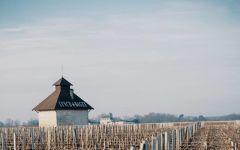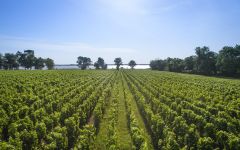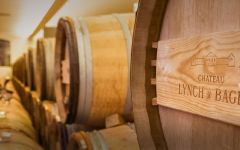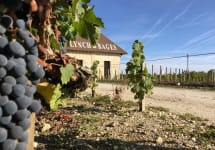Chateau Lynch-Bages 2005
-
Wine
Enthusiast -
Wine &
Spirits -
James
Suckling -
Wine
Spectator -
Robert
Parker -
Connoisseurs'
Guide



Product Details
Your Rating
Somm Note
Winemaker Notes
Professional Ratings
-
Wine Enthusiast
Classic Lynch-Bages with just a bit of extra power and richness. While the tannins are structured, it is the velvety fruit that rolls around the mouth that is the most dominant character. It is coming together into a wine that will be big and dense, but never over the top.
-
Wine & Spirits
There's a relaxed feel to this wine. Cazes's team can dress Lynch-Bages in the black-tie formality of a first growth, but the wine is still lovely-a touch of gaminess makes it friendly rather than ponderous. There's something ethereal about its tannins, like a chocolate truffle melting in the mouth. (Daniel Llose used 80 percent new oak for this vintage; the yields were short so there were more new barrels to go around, and at a tannic index of 82, the wine could handle it). Pure black cherry flavor saturates the wine with freshness; the complexity is intriguing and silken rather than aggressive. This should be readily accessible at ten to 20 years of age and should thrive for years after.
-
James Suckling
A meaty and decadent Lynch with very ripe currant aromas on the nose. Full body, velvety-textured tannins and a powerful finish. It shows so much structure and fruit yet remains polished and focused. Lovely now to drink but better in 2017.
-
Wine Spectator
Displays very beautiful aromas of crushed blackberry and dark chocolate, with a hint of coffee. Full-bodied, with a tightly wound palate of ripe tannins. Long and caressing.
-
Robert Parker's Wine Advocate
As for the 2005 Lynch-Bages, it is a sexy, surprisingly soft and accessible style of wine, with a deep ruby/purple color, loads of crème de cassis, cedar wood and forest floor notes, medium to full body, ripe tannin and a long, fleshy finish. Drink it over the next 15+ years.
-
Connoisseurs' Guide
At once both well-ripened and a bit backward with respect to fruit, this solid, moderately tannic young wine shows glimmers of sweet oak, cassis, raspberries and new leather that portend very good things to come once it has grown past adolescence. For now, it is a bit on the hard side, but, that said, it hangs on and on at the finish in a way that makes us more optimistic than not about where it will go.
Other Vintages
2024-
James
Suckling - Vinous
-
James
Suckling - Vinous
-
Jeb
Dunnuck - Decanter
-
Robert
Parker
-
Wilfred
Wong -
Jeb
Dunnuck -
James
Suckling - Decanter
-
Wine
Spectator -
Robert
Parker
-
Wine
Enthusiast -
James
Suckling - Decanter
- Vinous
-
Wine
Spectator -
Jeb
Dunnuck -
Robert
Parker
-
James
Suckling -
Wilfred
Wong -
Wine
Enthusiast - Decanter
-
Jeb
Dunnuck -
Wine
Spectator -
Robert
Parker
-
Jeb
Dunnuck -
James
Suckling - Decanter
-
Wine
Spectator -
Robert
Parker
-
Jeb
Dunnuck -
Wine
Spectator -
James
Suckling -
Wine
Enthusiast - Decanter
-
Robert
Parker -
Wilfred
Wong
-
Wine
Enthusiast -
James
Suckling - Decanter
-
Jeb
Dunnuck -
Wine
Spectator -
Robert
Parker
-
Robert
Parker -
Wine
Spectator -
James
Suckling - Decanter
-
Jeb
Dunnuck -
Wine
Enthusiast -
Connoisseurs'
Guide
-
Wine
Enthusiast -
James
Suckling - Decanter
-
Jeb
Dunnuck -
Wine
Spectator -
Wilfred
Wong -
Robert
Parker
-
James
Suckling -
Wine
Enthusiast - Decanter
-
Robert
Parker -
Wine
Spectator -
Jeb
Dunnuck
-
Wine
Enthusiast -
James
Suckling -
Wine
Spectator -
Wilfred
Wong
-
Wine
Enthusiast -
James
Suckling -
Wine
Spectator -
Robert
Parker -
Wilfred
Wong - Decanter
-
James
Suckling -
Robert
Parker - Decanter
-
Wine
Enthusiast -
Wine
Spectator -
Wilfred
Wong
-
Robert
Parker -
Wine
Enthusiast -
Wine
Spectator -
James
Suckling - Decanter
-
Wine
Enthusiast -
Robert
Parker -
Connoisseurs'
Guide -
Wine
Spectator
-
Robert
Parker -
Wine
Enthusiast -
James
Suckling -
Wine
Spectator -
Connoisseurs'
Guide -
Wine &
Spirits
-
Wine
Enthusiast -
Wine &
Spirits
-
Robert
Parker -
Wine
Enthusiast -
Wine
Spectator
-
Robert
Parker -
Wine
Spectator
-
Robert
Parker -
Wine
Spectator
-
Robert
Parker -
Jeb
Dunnuck -
Wine
Spectator -
Wine
Enthusiast -
James
Suckling -
Wine &
Spirits
-
Robert
Parker
-
Wine &
Spirits -
Wine
Spectator
-
Robert
Parker -
Wine
Spectator
-
Wine
Spectator
-
Robert
Parker -
Wine
Spectator
-
Robert
Parker -
Wine
Spectator -
James
Suckling
-
Wine
Spectator -
Robert
Parker
-
Robert
Parker -
Wine
Spectator
-
Wine
Spectator -
Robert
Parker
-
James
Suckling -
Robert
Parker -
Wine
Spectator








The grapes are all hand picked and then carefully sorted before crushing. A very strict selection is made prior to blending and the wine is traditionally aged in oak barrels before bottling.

One of the world’s most classic and popular styles of red wine, Bordeaux-inspired blends have spread from their homeland in France to nearly every corner of the New World. Typically based on either Cabernet Sauvignon or Merlot and supported by Cabernet Franc, Malbec and Petit Verdot, the best of these are densely hued, fragrant, full of fruit and boast a structure that begs for cellar time. Somm Secret—Blends from Bordeaux are generally earthier compared to those from the New World, which tend to be fruit-dominant.

The leader on the Left Bank in number of first growth classified producers within its boundaries, Pauillac has more than any of the other appellations, at three of the five. Chateau Lafite Rothschild and Mouton Rothschild border St. Estephe on its northern end and Chateau Latour is at Pauillac’s southern end, bordering St. Julien.
While the first growths are certainly some of the better producers of the Left Bank, today they often compete with some of the “lower ranked” producers (second, third, fourth, fifth growth) in quality and value. The Left Bank of Bordeaux subscribes to an arguably outdated method of classification that goes back to 1855. The finest chateaux in that year were judged on the basis of reputation and trading price; changes in rank since then have been miniscule at best. Today producers such as Chateau Pontet-Canet, Chateau Grand Puy-Lacoste, Chateau Lynch-Bages, among others (all fifth growth) offer some of the most outstanding wines in all of Bordeaux.
Defining characteristics of fine wines from Pauillac (i.e. Cabernet-based Bordeaux Blends) include inky and juicy blackcurrant, cedar or cigar box and plush or chalky tannins.
Layers of gravel in the Pauillac region are key to its wines’ character and quality. The layers offer excellent drainage in the relatively flat topography of the region allowing water to run off into “jalles” or streams, which subsequently flow off into the Gironde.
